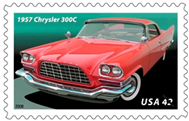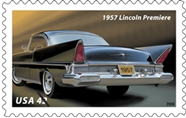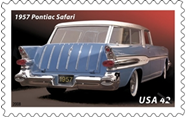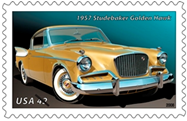
To obtain high-resolution images of the stamp for media use only, e-mail roy.a.betts@usps.gov.
CARLISLE, PA — America’s love affair with fast and flashy automobiles takes center stage on U.S. postage stamps with today’s issuance of the America on the Move: 50s Fins and Chrome stamps.
The new 42-cent stamps are now on sale at the local Post Office, by telephone at 800-Stamp-24 or online at usps.com.
Featuring paintings by renowned automobile illustrator Art M. Fitzpatrick, the stamps showcase a 1957 Chrysler 300C, a 1957 Lincoln Premiere, a 1957 Pontiac Safari, a 1957 Studebaker Golden Hawk and a 1959 Cadillac Eldorado. The stamps will be rolled out at the Fall Carlisle Collector Car Swap Meet & Corral during a first-day-of-issue ceremony in Carlisle, PA, at 12:30 p.m. ET.
“Automotive history is brilliantly illustrated on these awesome stamps,” said Patrick R. Donahoe, U.S. Postal Service deputy postmaster general and chief operating officer. “We are proud to feature these classic cars on stamps here at the mecca of car shows.”
Donahoe was joined by Carlisle Events co-founder Bill Miller Jr. to dedicate the stamps before a crowd of thousands of automotive enthusiasts.
The Postal Service inaugurated the America on the Move series in 2005 with the 50s Sporty Cars stamps that depicted a Nash Healey (1952), Chevrolet Corvette (1953), Studebaker Starliner (1953), Kaiser Darrin (1954) and a Ford Thunderbird (1955).
Background
America on the Move: 50s Fins and Chrome

1957 Chrysler 300C
During World War II, American carmakers devoted themselves to manufacturing military vehicles and aircraft. But after the war, peace and a booming economy propelled public demand for larger, faster, and more attractive cars. Manufacturers like Chrysler turned their attention to innovations in automotive design. The 1957 Chrysler 300C was the latest and most popular in the 300 Series, a line of high-performance luxury vehicles inaugurated in 1955. Part of Chrysler’s “Forward Look” design campaign, the 300C featured upswept tail fins and the powerful and efficient Hemi®, an engine with hemispherical combustion chambers originally developed for aircraft.
The award-winning 1957 Chrysler 300C was the first car in the 300 Series that was available as either a hardtop coupe or two-door convertible. It was large and low with a muscular 392ci Hemi® V-8 engine. The fully restyled front grille sported a round red-white-and-blue 300C emblem, an appropriate symbol for a vehicle rated America’s fastest car. Standard leather interior, “Flight-Sweep” styling, and minimal chrome trim added a sense of understated elegance and won legions of devoted drivers. Chrysler continued to produce cars in its original 300 Letter Car Series for 11 production years, ending with the 300L in 1965.

1957 Lincoln Premiere
Because public demand for new cars increased dramatically in the years following World War II, competitive carmakers were motivated to produce vehicles that were as stylish as they were dependable. As a result, Lincoln and other manufacturers gradually abandoned the round lines of pre-war designs in favor of a linear look. The 1957 Lincoln Premiere had a modern, aerodynamic appearance that appealed to car-buyers. Available as a hardtop coupe, convertible, or four-door sedan, the Premiere featured forward-leaning headlights and a long profile that created the illusion of speed.
First offered in 1956, the Premiere was restyled the following year, with dramatic results. Like its predecessor, the 1957 Lincoln Premiere featured tasteful chrome trim and clean lines. However, its tail fins sat higher and tilted outward, making the car appear wider from behind. The addition of “Quadra-Lites,” or dual vertical headlights, had an imposing effect on the front, while the new 368-cid 300-horsepower V-8 engine boosted power. A padded dash, wraparound windshield, and improved handling continued Lincoln’s reputation for security and comfort, as did standard power steering, brakes, windows, and driver’s seat. Lincoln satisfied customer demand with the introduction of the four-door Premiere Landau hardtop the same year.

1957 Pontiac Safari
The popularity of station wagons soared during the 1950s. With ample room for passengers, luggage, and souvenirs, wagons were useful for tooling around the neighborhood or traveling across the country. Pontiac issued its first two-door sports wagon—the Star Chief Custom Safari—in 1955. The Safari was based on the Chevrolet Nomad, and the two cars used many of the same parts. Featuring the doors of a sports coupe and the lush interior details of Pontiac’s top-of-the-line models, the Safari impressed drivers with easy handling, comfort, and the promise of excitement. By 1957, all Pontiac station wagons carried the name Safari.
The two-door, hardtop 1957 Star Chief Custom Safari carried up to six passengers and featured extra chrome detailing inside and out. Two-tone paint and Pontiac’s distinctive “Star Flight” styling—extended rear fenders, flattened tail fins, and missile-shaped trim—added to the youthful, sporty look, and the 347ci Strato-Streak V-8 engine pleased car-buyers with its high performance and dependability. Pontiac also introduced the roomy four-door Safari Transcontinental in 1957. Deciding to focus on its full-size station wagon models, the carmaker discontinued its two-door sports wagon line that year.

1957 Studebaker Golden Hawk
By the mid-’50s, more than half of all American families owned an automobile, and sports cars had become popular with car-buyers of all ages and backgrounds. Offering a comfortable ride and room for five passengers, the ’57 Golden Hawk—Studebaker’s distinctive hardtop coupe—combined the best elements of a sports car and a family sedan. With a body design based on the ’53 Studebaker Starliner, the Golden Hawk featured two-tone paint, a full-size trunk, and outward-leaning tail fins. A square grille, wraparound rear window, and wide, low body rounded out the popular design.
The Golden Hawk was first offered in 1956 along with three other Hawks: the Flight and Power Hawk coupes, and the hardtop Sky Hawk. With the Golden Hawk, they accounted for one-fourth of Studebaker sales that year. For 1957, Studebaker reduced its line of Hawks to two models: the Golden Hawk and the Silver Hawk coupe. The ’56 Golden Hawk’s Packard engine was replaced with a lighter 275-horsepower Studebaker 289ci V-8, which improved handling. A fiberglass hood overlay helped accommodate the new engine’s McCulloch supercharger, which boosted overall power by forcing more fuel and air into the cylinders. Although 1958 was the last year for the Golden Hawk, Studebaker continued to offer Hawks through 1964.

1959 Cadillac Eldorado
Cadillac first offered a car with modest tail fins in 1948, sparking the trend that would define the 1950s. When the carmaker introduced the Eldorado in 1959, it led the fad to its highest peak yet. Inspired by advances in aviation and space exploration, the dramatic tail fins of the 1959 Cadillac Eldorado were the tallest on the market. Their tops reached more than three feet above the ground. Equipped with a host of extravagant features, including leather interior and twin, bullet-style tail lights, the Eldorado—Spanish for “The Gilded One”—truly lived up to its name.
Cadillac introduced the Eldorado in limited quantities in 1953, producing only 532 that year. Nevertheless, this low-slung and stylish convertible became its own institution, and the touchstone of Cadillac’s reputation for luxury, for nearly 50 years. The flamboyant 1959 model featured a 345-horsepower 390ci V-8 engine and was capable of reaching 130 miles per hour. Standard features like air suspension, power brakes and steering, power windows, and two-way power seats added comfort and luxury. The car was available as either a hardtop (the Eldorado Seville) or a convertible (the Eldorado Biarriatz). A four-door hardtop Eldorado Brougham model was also produced in limited quantities.
America on the Move: 50s Fins and Chrome Philatelic Fact Sheet
Philatelic Products
There are five philatelic products available for this stamp issue:
- 463663, First-Day Cover Set/5, $4.00
- 463666/893500/893501, Premium Stamped Cards Set/20, $13.95
- 463668, Digital Color Postmark Set/5, $7.50
- 463691, Ceremony Program, $6.95
- 463699, Digital Color Postmark Cancellation Keepsake, $15.90
(Sheet of 20 stamps with set of 5 first-day-of-issue covers)
How to Order First-Day Covers
Stamp Fulfillment Services also offers first-day covers for new stamp issues and Postal Service stationery items postmarked with the official first-day-of-issue cancellation. Each item has an individual catalog number and is offered in the quarterly USA Philatelic catalog. Customers can request a free catalog by calling 800-STAMP-24 or writing to:
Information Fulfillment
Dept 6270
U.S. Postal Service
PO Box 219014
Kansas City, MO 64121-9014
How to Order the First-Day-of-Issue Postmark
Customers have 60 days to obtain the first-day-of-issue postmark by mail. They can purchase new stamps at their local Post Office, by telephone at 800-STAMP-24, or at the Postal Store website at www.usps.com/shop. They should affix the stamps to envelopes of their choice, address the envelopes to themselves or others, and place them in a larger envelope addressed to:
America on the Move: 50s Fins and Chrome Stamp
Postmaster
66 W Louther Street
Carlisle, PA 17013-9998
After applying the first-day-of-issue postmark, the Postal Service will return the envelopes through the mail. There is no charge for the postmark. All orders must be postmarked by Dec. 4, 2008.
Stamp Artist Art Fitzpatrick
Renowned automobile artist Art M. “Fitz” Fitzpatrick www.fitz-art.com designed cars before he embarked on a decades-long career as an illustrator specializing in car advertising art. Fitzpatrick attended art classes at Detroit’s Society of Arts and Crafts (today the College for Creative Studies) and the Detroit School of Art. He was only 20 when he designed the Darrin Packard 4-door convertible and hard-top sedans. While working for noted car designers and coach builders John Tjaarda (Briggs Body), Werner Gubitz (Packard), and "Dutch" Darrin, Fitzpatrick custom-built cars for personalities such as Clark Gable, Errol Flynn, and Al Jolson.
After serving as a naval officer during World War II, Fitzpatrick turned to advertising art—producing ads for General Motors; Lincoln/Mercury; Nash; Chrysler; Dodge; DeSoto; Plymouth; Kaiser; Studebaker; and Buick—all the while turning down offers to return to the automotive industry. In 1953 Buick signed him to an exclusive contract beginning what would become a 21-year association with General Motors automobiles: Buick, Pontiac, and Opel. For 13 years, he created an award-winning and widely imitated car advertising campaign for Pontiac. In 1958 he designed and produced the General Motors Golden Anniversary Book.
In addition to his work for General Motors, Fitzpatrick also created product and graphic design and art for clients such as General Electric, Texaco, Quaker State, and Chris-Craft and editorial art for LIFE, Look, Esquire, and Automobile Quarterly. His art has been honored with more than 40 art and design awards. A former member of the Society of Industrial Designers, Society of Automotive Engineers, and the Institute of Aeronautical Sciences, Fitzpatrick is today an honorary member of the Automotive Fine Arts Society and the Classic Car Club of America. His original art continues to be exhibited nationwide and Fitzpatrick himself often presents lectures as part of these exhibitions. The stamp art for America on the Move: 50s Sporty Cars (2005) is his first project for the U.S. Postal Service.
###
Please Note: For broadcast quality video and audio, photo stills and other media resources, visit the USPS Newsroom at http://about.usps.com/news/welcome.htm.
A self-supporting government enterprise, the U.S. Postal Service is the only delivery service that reaches every address in the nation — 151 million residences, businesses and Post Office™ Boxes. The Postal Service™ receives no tax dollars for operating expenses, and relies on the sale of postage, products and services to fund its operations. With 32,000 retail locations and the most frequently visited website in the federal government, usps.com®, the Postal Service has annual revenue of more than $65 billion and delivers nearly 40 percent of the world’s mail. If it were a private sector company, the U.S. Postal Service would rank 35th in the 2011 Fortune 500. In 2011, Oxford Strategic Consulting ranked the U.S. Postal Service number one in overall service performance of the posts in the top 20 wealthiest nations in the world. Black Enterprise and Hispanic Business magazines ranked the Postal Service as a leader in workforce diversity. The Postal Service has been named the Most Trusted Government Agency for six years and the sixth Most Trusted Business in the nation by the Ponemon Institute.
Follow the Postal Service on www.twitter.com/USPS and at www.facebook.com/USPS.

